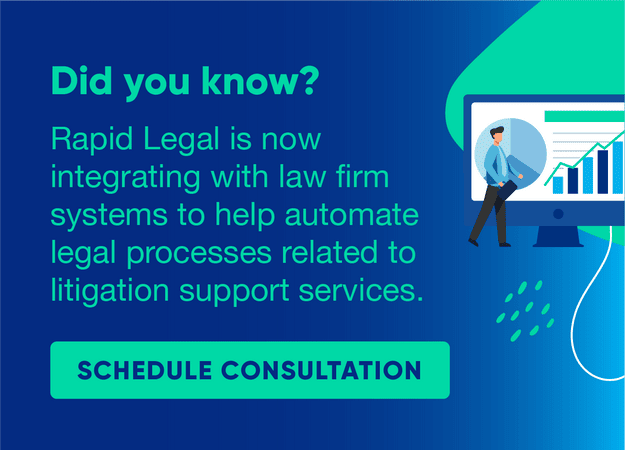
When you get right down to it prime rib and pomme fondant are just high-performing meat and potatoes that use technology to live up to their potential. Within the legal profession few things say “meat and potatoes” more than service of process. It may not be sexy but if you wrap service of process around an innovative technology platform it becomes a cost-cutting engine that improves performance on every single order.
If you want this kind of power in your service of process but don’t know where to begin, this article will help you reach your destination.
This is your starting point.
Black’s Law Dictionary offers a colorless definition of service of process that somehow overlooks the utterly ripped engineering muscle behind technology-enabled service of process:
The term for the delivery of a summons, writ or subpoena to the opposing party in a lawsuit.
That definition misses two critical factors that differentiate technology-enabled service of process orders in the present day: Online execution and sharable data.
Online execution singlehandedly pulled service of process into the 21st century for many law firms. This happened when software engineers developed an electronic portal that allows many types of litigation support services to be performed from a single access point.
The portal made service of process more convenient to order and more efficient to track and complete, while extending those same advantages to eFiling, physical court filings, courtesy copy retrieval, document retrieval, skip tracing and more. The portal allows the user to submit, manage, track, and execute each order right from the desktop. It doesn’t change the fact that service of process still has to be effected physically but that’s a story for another day, or article.
5% growth in 3 years
Technology spreads financial optimism. A majority of corporate CIOs surveyed believe digitally empowered employees can drive a revenue increase of 5% over 3 years, according to Forbes Insights.
What are you waiting for?
The technology behind electronically submitted service of process orders is also a boon to long-term law firm strategy because it makes data about process service orders in your vendor’s system shareable with your own systems. As a result, information about billing, court fees, vendor fees, and payments, is available at your fingertips.
If you’re unclear about how sharing this data positively impacts the bottom line, think of it this way: For each case, every transaction receipt and every document can be stored in a law firm’s own system. This means fees and payments can be easily accounted for and reimbursed when the case ends, dramatically collapsing the time needed to reconcile expenses.
A portal also allows the vendor to manage and efficiently track the performance of its affiliate network in executing the serve. This, in turn, builds an extremely high level of accountability felt all along the service of process supply chain.
The portal also creates two other important advantages to improve SOP efficiency: it eliminates paper controls and allows the server to eSign the proof of service.
From a high-level view, vendors that have this portal/technology are typically able to provide superior service because they can further leverage their internal expertise, reduce errors, provide more timely updates, and better prioritize each order. Though the technology behind the portal may be invisible to the law firm, the positive effect it has on the vendor’s performance will be easy to spot in orders that are cost-efficient and have lower rejection rates.
An early warning system
Sharable data can also be used to create strategic reports. These reports provide detailed views of service of process orders and the vendor’s execution thereof, as well as other order types placed through the portal. At a glance, users can see which types of orders contribute positively to the firm’s bottom line and which types compromise it.
This data allows you to course-correct by setting up cost control measures if needed. Likewise, you can use them to monitor throughput, detect trends, and analyze your firm’s and the vendor’s performance.
Most law firms aren’t equipped to gather this type of business intelligence easily on their own. However, gathering this data from a vendor whose technology allows them to share it is simple, and takes only a fraction of the time and money required for a staff member to develop the same reports in-house.
Here are four examples of how you can use sharable data in your firm’s business strategy:
Service level distribution: Are you paying for the most expensive level of service when the least expensive service meets your needs? Data in this report track process serving orders by service level, so you can analyze the service you’re buying and make sure it’s the service you actually need.
Orders by type: Stop guessing. Find out for certain how and where the greatest volume of your work lies. Is it eFiling, service of process, or something else? Review the data and then decide whether to make adjustments to your firm’s resources or reset customer expectations.
Service of process orders by pricing zone: An easy-to-read pie chart identifies the areas where your service of process orders are being delivered. Use this data to determine how much you’re spending on costly deliveries to remote areas compared to less expensive urban areas. The answer can keep you from losing money on serves done in those outlying areas.
Service of process performance: Clients care about your scoreboard. If you use your success rate with documents served and proofs of service to help sell your firm, these numbers will back you up nicely.
Next-level productivity? Just push play
Most industries adopt technology to improve accuracy or increase efficiency. Law firms can use technology to improve both of those dimensions by managing their online service of process orders with the same ease as orders that require boots on the ground.
It happens like this:
- A law firm staff member uses the portal to do the physical filing, and in the same workflow creates the service of process. The vendor’s staff—not the law firm staff—manages the dependencies.
- The vendor staff waits until the conformed copy is returned by the court before dispatching the serve order.
- The vendor receives the proof, files it, and the SOP is then really complete.
A significant portion of this entire process is shifted to the vendor, which frees up more billable hours among law firm staff. If your firm does a significant volume of work, the amount of time this approach will save tallies up quickly.
17%
Saving time is a common aim for most law firms. The time employees spend on manual processes drops by 17% among firms that make business software available and accessible to its workers.
Technology boosts efficiency.
What you want in a vendor
Using a litigation support services vendor with a great tech stack is an excellent way for law firms to strengthen their performance. To help you start your search on the right foot we’ve put together a few helpful tips.
First, look for a vendor that provides an online portal from which you can manage and measure every litigation support service order you place.
Not just service of process, but eFiling, physical court filing, expert document review, skip tracing, and others.
Second, you’ll want to know your firm’s rejection rate. A good benchmark to measure their performance is to look for a court filing success rate approaching 90%. When you find a vendor that has one or more clients doing more than 1,000 filings a month and a 95% acceptance rate, you’re wise to sit down and have a serious conversation about service of process too.
Get to know eService
When vendors begin to jockey for a coveted position as your preferred vendor, the third thing you should ask about is eService. Not to be confused with the similar term, “electronic service of process,” eService refers to a method of electronically notifying parties about a document that has been filed or submitted.
Here’s an easy way to understand how eService works and the benefits it provides.
Once the primary papers of a case have been served, eService allows all the documents that need to move back and forth between the parties or their counsel to flow electronically. No more couriers or loose papers. Once litigation gets underway, the court simply provides email addresses where documents can be sent, then—using eService notification—a notice is sent to the other party or their counsel.
More law firms are demanding eService because it fits seamlessly with electronic workflows that execute court filings, perform order tracking, provide SOP, and proofs of service from one portal. The automated email notices help make sure critical notifications don’t fall between the cracks. Also, where eFiling is mandatory, eService is also. Parties can agree to use eService in other circumstances.
If you’re still unclear about how to differentiate the crowded field of services that begin with “e,” you can lift the fog by reading Did You Know? eFiling vs. eDelivery and eSubmit are NOT the Same! in only 5 short minutes.
Start your vendor search now.
Build out your interview questions with this article written specifically for legal professionals:
What to Look for When Hiring a Process Serving Company
Partnership + Platform = Possibilities
By default, your vendor’s innovation becomes your innovation, so it’s in your best interest to find a company that uses a best-of-breed technology platform. When you’re interviewing vendors be sure to ask about the platform they use for service of process, and be specific.
For example, you may want a portal that allows you to handle the full spectrum of physical and electronic services, in addition to expert document review and document retrieval. If more than one vendor appears to offer this service, focus on the one that has an established track record of providing timely and accurate services, and has a platform that can integrate with law firm systems to easily enable data sharing.
It’s also in your best interest to use a vendor whose portal is protected by bank grade security and whose technology platform is accepted by the greatest number of courts in California.
If your selection process begins to bog down, narrow your search only to vendors that can create synergies that give both sides a win. To see an example of these synergies in action check out this article on our blog. You’ll discover how a leading law firm and litigation support services vendor lift each to higher levels of performance, simply by taking advantage of a technology platform and thinking creatively. If a vendor can’t provide this type of responsiveness, find one that can.
Set yourself up for service of process success with careful preparation. Understand your own needs, qualify a vendor whose technology meets those needs, and keep in mind that the point of a strategic partnership is not to do all the work yourself, but to know how to get the work done.
Service of process isn’t rocket science, but it is meat and potatoes that the court system can’t live without. Make sure yours is cooked? Prepared? to perfection.
Wheels Still Turning?
Our sales team can help you find more ways to make service of process an efficiency engine for your law firm. Book a demo or schedule a call with a Rapid Legal team member to learn how the full scope of Rapid Legal’s portal capabilities can work for you.
Get Started Today
Spend more time on billable client hours and less time tracking down conformed copies and proofs of service.

